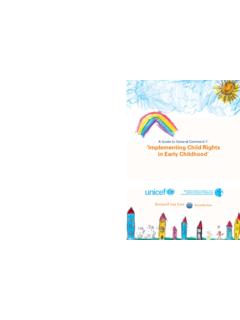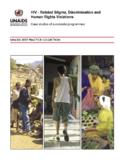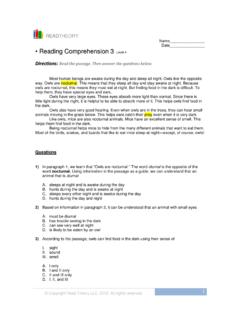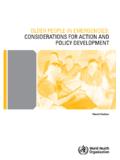Transcription of Distr. GENERAL HCR/GIP/09/08 Date: 22 December …
1 : 22 December 2009 Original: ENGLISH GUIDELINES ON INTERNATIONAL PROTECTION: Child Asylum Claims under Articles 1(A)2 and 1(F) of the 1951 Convention and/or 1967 Protocol relating to the Status of Refugees UNHCR issues these Guidelines pursuant to its mandate, as contained in the Statute of the Office of the United Nations High Commissioner for Refugees, in conjunction with Article 35 of the 1951 Convention relating to the Status of Refugees and Article II of its 1967 Protocol. These Guidelines complement the UNHCR Handbook on Procedures and Criteria for Determining Refugee Status under the 1951 Convention and the 1967 Protocol relating to the Status of Refugees (Reedited, Geneva, January 1992). These Guidelines are intended to provide legal interpretative guidance for governments, legal practitioners, decision makers and the judiciary, as well as UNHCR staff carrying out refugee status determination in the field.
2 1 Table of Contents I. 3 II. DEFINITIONAL 5 III. SUBSTANTIVE 6 a) Well-founded fear of 6 Child-specific 8 Child-related manifestations of 8 Child-specific forms of 9 b) Agents of 16 c) The 1951 Convention 17 Race and nationality or 17 17 Political 18 Membership of a particular social 18 d) Internal flight or relocation 20 e) The application of exclusion clauses to 22 IV. PROCEDURAL AND EVIDENTIARY 25 2 Child Asylum Claims under Articles 1(A)2 and 1(F) of the 1951 Convention and/or 1967 Protocol relating to the Status of Refugees I. INTRODUCTION 1. These Guidelines offer substantive and procedural guidance on carrying out refugee status determination in a child-sensitive manner. They highlight the specific rights and protection needs of children in asylum procedures.
3 Although the definition of a refugee contained in Article 1(A)2 of the 1951 Convention relating to the Status of Refugees and its 1967 Protocol (hereafter 1951 Convention and 1967 Protocol ) applies to all individuals regardless of their age, it has traditionally been interpreted in light of adult experiences. This has meant that many refugee claims made by children have been assessed incorrectly or overlooked 2. The specific circumstances facing child asylum-seekers as individuals with independent claims to refugee status are not generally well understood. Children may be perceived as part of a family unit rather than as individuals with their own rights and interests. This is explained partly by the subordinate roles, positions and status children still hold in many societies worldwide.
4 The accounts of children are more likely to be examined individually when the children are unaccompanied than when they are accompanied by their families. Even so, their unique experiences of persecution, due to factors such as their age, their level of maturity and development and their dependency on adults have not always been taken into account. Children may not be able to articulate their claims to refugee status in the same way as adults and, therefore, may require special assistance to do so. 3. Global awareness about violence, abuse and discrimination experienced by children is growing,2 as is reflected in the development of international and regional human rights standards.
5 While these developments have yet to be fully incorporated into refugee status determination processes, many national asylum authorities are increasingly acknowledging that children may have refugee claims in their own right. In Conclusion on Children at Risk (2007), UNHCR s Executive Committee underlines the need for children to be recognized as active subjects of rights consistent with international law. The Executive Committee also recognized that children may experience child-specific forms and manifestations of 4. Adopting a child-sensitive interpretation of the 1951 Convention does not mean, of course, that child asylum-seekers are automatically entitled to refugee status. The 1 UNHCR, Guidelines on Policies and Procedures in Dealing with Unaccompanied Children Seeking Asylum, Geneva, 1997 (hereafter UNHCR, Guidelines on Unaccompanied Children Seeking Asylum ), , in particular Part 8.
6 2 See, for instance, UN GENERAL Assembly, Rights of the Child: Note by the Secretary- GENERAL , A/61/299, 29 Aug. 2006 (hereafter UN study on violence against children ) ; UN Commission on the Status of Women, The elimination of all forms of discrimination and violence against the girl child, , 12 Dec. 2006, ; UN GENERAL Assembly, Impact of armed conflict on children: Note by the Secretary- GENERAL (the Machel Study ), A/51/306, 26 Aug. 1996, , and the strategic review marking the 10 year anniversary of the Machel Study, UN GENERAL Assembly, Report of the Special Representative of the Secretary- GENERAL for Children and Armed Conflict, A/62/228, 13 Aug.
7 2007, 3 ExCom, Conclusion on Children at Risk, 5 Oct. 2007, No. 107 (LVIII) - 2007, (hereafter ExCom, Conclusion No. 107 ), , para. (b)(x)(viii). 3child applicant must establish that s/he has a well-founded fear of being persecuted for reasons of race, religion, nationality, membership of a particular social group or political opinion. As with gender, age is relevant to the entire refugee As noted by the UN Committee on the Rights of the Child, the refugee definition: .. must be interpreted in an age and gender-sensitive manner, taking into account the particular motives for, and forms and manifestations of, persecution experienced by children. Persecution of kin; under-age recruitment; trafficking of children for prostitution; and sexual exploitation or subjection to female genital mutilation, are some of the child-specific forms and manifestations of persecution which may justify the granting of refugee status if such acts are related to one of the 1951 Refugee Convention grounds.
8 States should, therefore, give utmost attention to such child-specific forms and manifestations of persecution as well as gender-based violence in national refugee status-determination Alongside age, factors such as rights specific to children, a child s stage of development, knowledge and/or memory of conditions in the country of origin, and vulnerability, also need to be considered to ensure an appropriate application of the eligibility criteria for refugee 5. A child-sensitive application of the refugee definition would be consistent with the 1989 Convention on the Rights of the Child (hereafter the CRC ).7 The Committee on the Rights of the Child has identified the following four Articles of the CRC as GENERAL principles for its implementation:8 Article 2: the obligation of States to respect and ensure the rights set forth in the Convention to each child within their jurisdiction without discrimination of any kind;9 Article 3 (1): the best interests of the child as a primary consideration in all actions concerning children;10 Article 6: the child s inherent right to life and States parties obligation to ensure to the maximum extent possible the survival and development of the child.
9 11 and Article 12: the child s right to express his/her views freely regarding all matters affecting the child , and that those views be given due These principles inform both the substantive and the procedural 4 UNHCR, Guidelines on International Protection No. 1: Gender-Related Persecution Within the context of Article 1A(2) of the 1951 Convention and/or its 1967 Protocol Relating to the Status of Refugees, 7 May 2002 (hereafter UNHCR, Guidelines on Gender-Related Persecution ), , paras. 2, 4. 5 UN Committee on the Rights of the Child, GENERAL Comment No. 6 (2005): Treatment of Unaccompanied and Separated Children Outside Their Country of Origin, CRC/GC/2005/6, Sep.
10 2005 (hereafter CRC, GENERAL Comment No. 6 ), , para. 74. 6 UNHCR, Guidelines on Unaccompanied Children Seeking Asylum, op cit., page 10. 7 With a near universal ratification, the CRC is the most widely ratified human rights treaty, available at The rights contained therein apply to all children within the jurisdiction of the State. For a detailed analysis of the provisions of the CRC, see UNICEF, Implementation Handbook for the Convention on the Rights of the Child, fully revised third edition, Sep. 2007 (hereafter UNICEF, Implementation Handbook ). It can be ordered at 8 CRC, GENERAL Comment No. 5 (2003): GENERAL Measures of Implementation for the Convention on the Rights of the Child (Arts.)

















